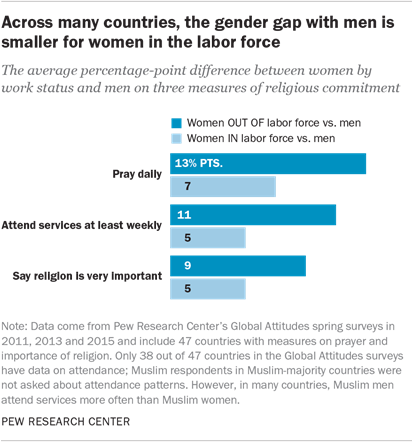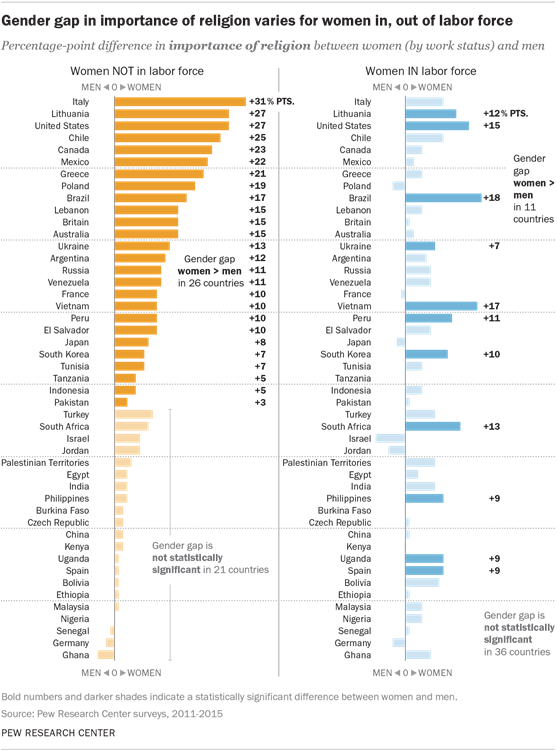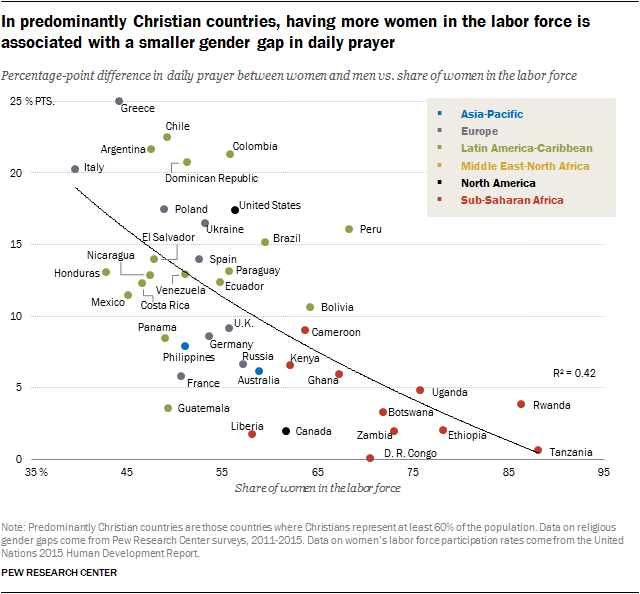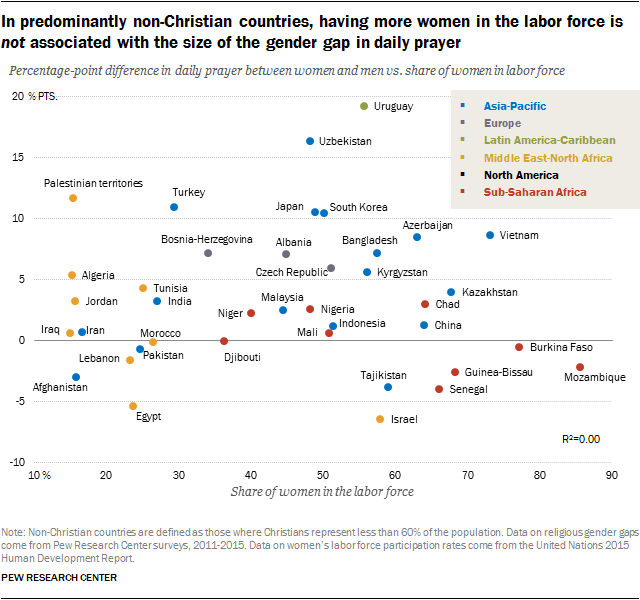Women’s generally greater level of religiosity has been observed by scholars for decades; it has shown up in surveys going back as far as the 1930s.34 But not until the 1980s did academics begin a concerted effort to find an explanation for the phenomenon.35
Initially, some scholars assumed women were universally more religious across all religions and cultures. This assumption was likely reinforced by the early concentration on patterns of religious behavior in predominantly European and North American countries with large Christian populations. Gradually, however, as studies paid increasing attention to other faiths and countries, different patterns of gender differences were detected. Researchers began to find that while women generally were more religious than men, this was not always the case.
More than three decades of research have yielded a large quantity of data and a greater appreciation for the complexities of the relationship between gender and religion – complexities reflected in the data presented in this report. But a definitive, empirically based explanation of why women generally tend to be more religious than men remains elusive. Indeed, as two experts recently wrote, this widely observed pattern is still “a genuine scientific puzzle.”36
Here is a brief summary of some leading theories proffered by experts who have examined the religious gender gap. The explanations generally fall into three broad categories: nature, nurture or a combination of both.37
Nature explains it
Under the “nature” umbrella are theories that variously attribute gender differences in religious commitment to physical or physiological causes such as hormones, genes or biological predispositions.
For example, Baylor University sociologist Rodney Stark postulates that men’s physiology – specifically their generally higher levels of testosterone – accounts for gender differences in religion. His argument rests on what he views as increasing evidence that testosterone is associated with men’s greater propensity to take risks, which he argues is why men are less religious than women. By inference, women are more religious because they have less risk-promoting testosterone.38
Stark’s theory elaborates on an earlier thesis introduced by sociologists John P. Hoffman of Brigham Young University and the late Alan S. Miller. They noted that men appear to have a greater innate tendency to take risks, and therefore are more willing than women to gamble that they will not face punishment in the afterlife. As a result, men are less religious. Since women are generally more risk-averse, this theory posits, they turn to religion to avoid eternal punishment or to secure a place in heaven. Unlike Stark, Hoffman and Miller do not assign a specific source for men’s greater willingness to take risks.39
Baylor University’s Matt Bradshaw and Christopher G. Ellison of the University of Texas at San Antonio argue for more exploration of genetic factors. Some studies of biological influences on religious life, they write, suggest that “genetic differences account for roughly a third of the variation” among individuals in various aspects of personal religious devotion. While the two sociologists recognize a role for social and environmental influences, they contend that “biological predispositions remain a viable, and untested, explanation for gender differences in religiosity.”40
Still within the nature framework, Jeremy Freese of Northwestern University and James D. Montgomery of the University of Wisconsin postulate that psychological differences could throw light on gender differences in religiosity. They advocate for more research into which psychological aspects are most influential on religious devotion and how differences are shaped by genes and social environments. In particular, they would like to see more investigation into how personality traits typically associated with “femininity” and “masculinity” relate to gender differences in religiosity.41 As an example of this type of research, they point to a 1991 study by Edward H. Thompson Jr., who surveyed the religiosity of 358 American undergraduates who had completed self-profiles using stereotypical feminine and masculine personality traits.42 Thompson found that “religiousness is influenced more by a ‘feminine’ outlook than by being female.”
Nurture explains it
In the nurture category are theories that seek to explain the religious gender gap by such factors as socialization into traditional gender roles, lower rates of female workforce participation and national economic structures.
University of Aberdeen’s Marta Trzebiatowska and Steve Bruce, for example, contend that “nothing in the biological make-up of men and women … explains the gendered difference in religiosity.” These differences, the two sociologists write, are better explained by “an amalgam of different social facts” that include women’s dominant role in childbirth and death, which keeps women “closer to religion than men.” Another factor they cite is men’s pressure on women to be religious as a way to control female sexuality.43
But the dominant reason for the gender gap, in the view of Trzebiatowska and Bruce, is the “time lag” in the way secularization in modern times has affected men and women. Men’s pre-eminent roles in the workforce and public life meant they “were generally affected earlier than women by the secularizing forces that reduced the plausibility of religious beliefs and turned religious rectitude from a necessary condition for citizenship into a personal preference,” the two write. As women become more like men in activities outside the home, they theorize, women also may become more similar in levels of religiousness. Indeed, the authors speculate that the religious gender gap may eventually disappear entirely, as gender roles become more alike and gender equality becomes more commonplace: “Enough women are now free of the social roles that coincidentally brought them into the orbit of organized religion to destroy the web of expectations that disposed them to be more favorable, as a class, to religion.”
In a related vein, researchers have looked at how women’s place in society, especially their rates of workforce participation, might affect their religious commitment. Based on 1983 data from Australia, sociologist David de Vaus of the Australian Institute of Family Studies and political scientist Ian McAllister of Australian National University report that lower rates of female labor force participation “are the major cause” of women’s greater religious commitment. Indeed, they find that full-time female workers are not only less religious than women who do not work, but also display a religious orientation similar to men. Work outside the home, the two hypothesize, could provide “sociopsychological benefits” otherwise gotten from religion and “makes religion less important and less relevant for some people.”44
A somewhat different interpretation for working women’s lower religious commitment emerges from recent studies in the U.S. by Indiana University-Bloomington sociologist Landon Schnabel. He suggests that women in the labor force, particularly those in high-paying, full-time jobs, are less religious because they receive less social validation and affirmation from religious congregations compared with women who follow more gender-typical roles and expectations.45 Sociologist Linda Woodhead of Lancaster University theorizes that as Christian women in Europe and North America increasingly entered the labor force starting in the 1960s, they felt the need to create more independent, career-oriented identities separate from or alongside their identities as homemakers. But since most traditional forms of Christianity did not support working women’s new identities, women’s overall religiosity decreased. “In this complex project of completely refashioning identity, traditional forms of religion are more likely to prove a hindrance to women than a help,” Woodhead writes.46
An analysis of Pew Research Center data as it relates to female workforce participation and the gender gap is presented in a sidebar at the end of this chapter.
Social scientists David Voas, Siobhan McAndrew and Ingrid Storm, who are at the University College London and the Universities of Bristol and Manchester, respectively, argue that in Europe, the gender gap decreases (but does not disappear) with modernization. But they contend that the narrowing gap is due more to rising national income per capita than to secularization or growing gender equality. As women gain more security through economic development, “the appeal of religious commitment fades,” they write, adding that “it is also possible that with economic growth, women’s values converge with those of men in terms of secularity and rationality.”47
Their theory dovetails with that of Harvard University’s Pippa Norris and University of Michigan’s Ronald Inglehart, both political scientists, who propose that differences in “existential security” best explain the religious gender gap. “Women often give higher priority to religion not because of their sex per se, but because they usually experience less security in their lives,” being more vulnerable than men to the hardships of “poverty, debt, poor health, old age and lack of physical safety,” they write. For this reason, “women give higher priority to security – and religion,” which “provides a sense of safety and well-being.”48
A synthesis
The nature versus nurture debate is not likely to be settled anytime soon. The “nature” theories that focus on physical, biological or genetic differences between men and women have not found a measurable factor that has been definitively linked to greater religiosity. And the “nurture” theories that pinpoint social factors as the principle mechanism in explaining the religious gender gap all face a problem: Despite the vast social changes and gender role transformations of recent decades, the religious gender gap persists in many societies. As a result, contemporary scholars of religion seem increasingly to be converging on a consensus that the religious gender gap most likely arises from a complicated mix of multiple factors. As one scholar put it, “greater insight into gender differences in religiousness lies … in the acceptance of complexity.”49
Do patterns of female labor force participation help explain the religious gender gap?
One theory discussed in Chapter 7 on why women generally tend to be more religious than men is that, in many societies, women are less likely than men to work in the labor force, a social role that some studies find is associated with lower levels of religious commitment. Scholars note that a focus solely on home management, which involves more attention and time spent raising children and caring for sick or elderly relatives, appears to encourage stronger religious commitment and more frequent religious activity.50 Conversely, work often interferes or competes with involvement in a religious community, which can lead to less-frequent attendance at worship services and weaken a person’s religious identity. Work also offers alternatives around which to construct personal and community identities. In addition, it can broaden horizons beyond the family, exposing people to new ideas and ways of life that can challenge traditional religious dogma. Some experts also hypothesize that women in the labor force seek to conform to a prevailing male ethos that may not affirm religious commitment.
Testing the labor force theory
The labor force theory of the religious gender gap leads to two hypotheses. First, women working in the labor force should be less religious than women outside the labor force and therefore more similar to men in their levels of religious commitment. Second, in the aggregate, countries with larger shares of women working in the labor force should have smaller gender gaps overall, compared with countries where few women are in the labor force.
 The first hypothesis is supported by a Pew Research Center analysis of data from 47 countries with measures of employment status and religious commitment.51 Across these countries, women working in the labor force are less religious, on average, than women outside the labor force across three measures of religious commitment. As a result, the religious gender gaps between women working in the labor force and men are much smaller than the gaps between women not working for pay and men.52 For example, women working in the labor force are more likely than men to pray daily by an average of 7 percentage points, whereas women not in the labor force are more likely than men to pray daily by an average of 13 percentage points. These patterns persist even after accounting for characteristics other than women’s work status, such as educational attainment, age, marital status and religious affiliation (for more details, see the report Methodology).
The first hypothesis is supported by a Pew Research Center analysis of data from 47 countries with measures of employment status and religious commitment.51 Across these countries, women working in the labor force are less religious, on average, than women outside the labor force across three measures of religious commitment. As a result, the religious gender gaps between women working in the labor force and men are much smaller than the gaps between women not working for pay and men.52 For example, women working in the labor force are more likely than men to pray daily by an average of 7 percentage points, whereas women not in the labor force are more likely than men to pray daily by an average of 13 percentage points. These patterns persist even after accounting for characteristics other than women’s work status, such as educational attainment, age, marital status and religious affiliation (for more details, see the report Methodology).
Pew Research Center’s analysis of the data also shows that this general pattern varies across countries. In many countries with large Christian populations, such as Italy, Greece, Chile, Mexico and the United States, women working in the labor force are much less religious than women outside the labor force and are more similar to men. The pattern is different, however, in sub-Saharan Africa, where in countries such as Kenya and Ethiopia, women and men tend to show similarly high levels of religious commitment, regardless of women’s work status. Meanwhile, labor force participation also appears to be less of a factor in many Muslim-majority countries, where there are smaller gender gaps in religious commitment to begin with, as well as in other non-Christian countries such as India and China. Despite these variations, the analysis finds that labor force participation is associated with lower levels of religious commitment for women, on average, leading to a smaller gender gap with men than the gender gap between women outside the labor force and men.

The second hypothesis of the labor force theory anticipates that the share of women working in the labor force should have consequences for the size of the overall gender gap between women and men. In countries where most women stay in the home and few work in the labor force, overall gender gaps in religious commitment should be relatively large. And by contrast, countries with high levels of female labor force participation should have smaller gender gaps.
To test this second hypothesis, researchers combined data on the religious gender gaps among the general population in 81 countries using Pew Research Center surveys with data from the United Nations on the shares of women (ages 15 and older) working in the labor force and other country characteristics.53
The analysis finds support for this hypothesis on daily prayer across countries where Christians represent at least 60% of the total population. Among these predominantly Christian nations, those with larger shares of women working in the labor force tend to have smaller gender differences in daily prayer (e.g., Ethiopia, Rwanda, Tanzania) compared with countries where smaller shares of women are in the labor force (e.g., Italy, Greece, Argentina). Moreover, the strong association between female labor force participation and the gender gap in daily prayer across predominantly Christian countries remains significant even after accounting for national income.54
However, women’s labor force participation does not appear to be related to the gender gap in daily prayer across Muslim-majority countries or across countries where neither Christianity nor Islam are predominant (e.g., India, China, Israel). In these countries, differences in the shares of women in the labor force do little to explain why some countries have large religious gender gaps and others have smaller ones.
This pattern – a strong negative association between the share of women in the labor force and the gender gap across predominantly Christian countries, and a lack of association across other countries – is clearest when it comes to the gender gap in daily prayer, but a similar pattern is observed in importance of religion.55


There are several possible reasons the pattern is different in predominantly Christian countries compared with others. One factor could be how religion is socially framed as feminine or masculine. Some scholars have suggested that norms spread by Christian leaders in some countries have affirmed the role of women in the home, strengthening the religious commitment of women outside the labor force while indirectly undermining the religious commitment of women in the labor force.56
Additional factors that might explain the varied relationships between women’s work status and the religion gender gap across countries include different cultural and religious perceptions of whether it is socially acceptable for men or women, regardless of work status, to skip weekly worship services or daily prayers. In addition, the kinds of jobs that men and women hold may differ from country to country, leading to different consequences for the relationship between labor force participation and religious commitment. For example, while large shares of women participate in the labor force in sub-Saharan Africa, their jobs often provide little economic security or stability. This may lead these women to rely more heavily on religion as a source of comfort and social support compared with women who hold better-paying jobs in more economically developed countries.


